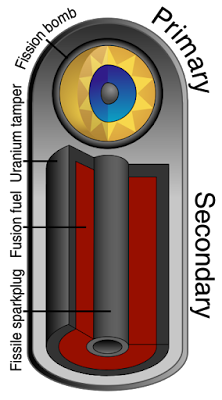In an unwelcome surprise to neighbouring countries reports on January 6, 2016 are that North Korea has claimed it conducted a
"successful hydrogen” bomb test, See "Approximate test site" on the map above. If true this would be North Korea's fourth nuclear test.
The device was apparently tested 10 km underground at
the Punggye-ri test site in the far northeast North Korea. The
explosion was detected as a magnitude 5.1 earthquake by the US Geological
Survey (which has sites dotted around the world, including sensors in South
Korea and in China as well as satellite backup).
The test is the second since Kim Jung-un (third in the Kim Dynasty) appointed himself leader. Kim Jung-un has been consolidating his power through fear with some highly advertised executions of key officials.
The South Korean Meteorological agency confirmed the "earthquake" was man-made ie. a bomb. The bomb might conceivably be: 100s tons of conventional explosive; a normal atomic (fission) bomb; a fusion boosted fission; or, less likely, a true two stage hydrogen bomb. It will take days for USAF
The nuclear test may represent an improvement in North
Korea's nuclear weapons device and nuclear explosive capabilities.
If North Korea has actually conducted a hydrogen bomb test this may the first of several tests to prove reliability.
But "hydrogen bomb" need not mean the very powerful two stage hydrogen bomb. Hydrogen bombs can include far less powerful fusion boosted fission devices. Such a fusion boosted fission device may have been detonated by Pakistan in 1998 – then design plans and some parts passed to North Korea via the proliferation of A Q Khan with the help/knowledge of Pakistan’s military and political bosses.
Example of a fusion boosted fission device which might more likely be closer to North Korea's claimed "hydrogen bomb".
---
North Korea may have tested a fusion
boosted fission weapon (example diagram above). This usually
refers to a type of nuclear bomb that uses a small amount of fusion fuel to increase the rate, and thus yield, of a fission reaction. This is technically a partial hydrogen bomb but not the much more powerful two stage fusion device more popularly known as a Hydrogen Bomb.
There is a possibility that North Korea intended the 4th, and indeed 3rd (2013) tests, as testing the Atomic (fission) bomb Primary of a future two stage Hydrogen (aka "thermonuclear" and "fusion") Bomb.
---
Almost simultaneous is Washington Free Beacon's report on January 5, 2016 that a North Korean SLBM ejection test occurred on December 21, 2015. If that ejection test was successful that may also represent an improvement of North Korea's nuclear weapon capabilities. This time in terms of less vulnerable weapon delivery means. The Free Beacon reports that North Korea conducted this latest SLBM test near North Korea’s eastern port of Sinpo after a similar attempt was said to have failed in November 2015. An ejection test may just mean blasting (maybe with compressed gas) an inert missile out of a submarine chamber or out of a floating pontoon. Not necessarily including actual ignition of a missile’s first stage rocket motor.
Aficionados of nuclear weapons might assess that North Korea has just announced improvements in the three important areas (device, nuclear explosive and weapon delivery means) of a nuclear program.
The South Korean Foreign Ministry and the Secretary General
of the UN (who is a South Korean) have called an emergency Meeting of the UN
Security Council.
More on the chilling world of nuclear weapon design is here.
Pete



No comments:
Post a Comment
You can comment :)